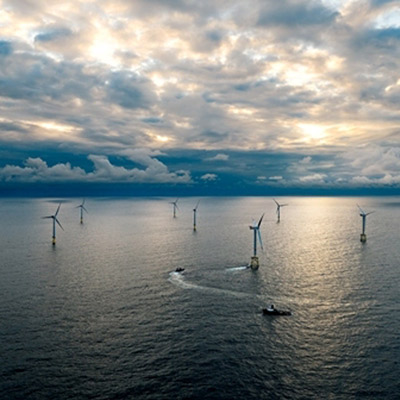Referat Schiffbau
Brandstwiete 1
20457 Hamburg

Gabriele Leuer
Phone: +49 40 361 37-249
Mail: schiffbau@bg-verkehr.de
Offshore service vessels
- What are offshore service vessels?
- High speed offshore service vessels
- Offshore service vessels with lower speed
- Work times on board
- No more Certificates of Equivalence
What are offshore service vessels?
The turnaround in energy policy would not be possible without offshore ships. In this segment many small offshore service vessels for offshore wind farms are deployed in German waters. These offshore service vessels transport mostly service and supervisory personnel to the offshore wind farms far away from the coast.
For offshore service vessels under German flag
- enganged on domestic voyages (regardless of the length of the ship) or
- enganged on international voyages with a length of less than 24m
the German "Schiffssicherheitsverordnung" (ship safety ordinance) applies.
Basically there are two different kinds of vessel categories among the offshore service vessels:
- High speed craft (HSC) built as a HSC that can operate with high-speed and
- slower service vessels that do not reach the lowest maximum speed of a high speed craft.

High speed offshore service vessels
High speed offshore service vessels under German flag have to observe the German "Schiffssicherheitsverordnung", in particular annex 1a part 6. These ships are cargo ships to which special regulations apply. The operator of such vessel may carry up to 60 people on these ships including the crew. Of these 60 people up to 12 may be passengers. The others have to be either crew members or offshore service personnel. The term offshore service personnel means someone engaged in the erection, the operation and maintenance of offshore wind farms and other offshore installations.
Chapter 6 of part 6 of annex 1a of the German ship safety ordinance includes a few facilitations in comparison to the HSC Code (International Code of Safety for High-Speed Craft). These special regulations are possible because offshore service vessels are sailing around the area of wind farms to which particular protection and safety concepts apply. Since there are wind farm installation vessels and accommodation ships or other ships at the wind farms enough rescue capacities are available. In addition, the offshore service personnel are specially trained for emergencies.
Offshore service vessels with lower speed
Some offshore service vessels do not fall in the category of high-speed craft because they do not reach their velocities. To determine whether an offshore service vessel should be certified as high-speed craft or not, the lowest maximum velocity for high-speed craft is calculated for the vessel according to the definition in Annex 1a Part 6 of the "Schiffssicherheitsverordnung" (ship safety ordinance).
If these slower vessels carry over 12 people, are engaged in international voyages and fly the German flag, the “Special Purpose Ship-Code” (SPS Code) of the IMO applies. If they are solely engaged in national voyages, generally, the "Schiffssicherheitsverordnung" (ship safety ordinance) Annex 1a Part 6 and Part 7 as well as the SPS Code of 2008 incl. Supplement 2010 apply.
Work times on offshore ships
On German merchants ships on which offshore work is done in the German coastal sea or in the German Exclusive Economic Area (EEA), the daily regular work time may be extended in accordance with the German Offshore Working Time Ordinance. In any other case, the work and rest time requirements of the German Maritime Labour Act, sections 42 to 55 apply.
No more Certificates of Equivalence
Up until 30 November 2024, sea-going vessels under foreign flag (also EU flag) that were
- operated commercially,
- deployed within German coastal waters (12 nautical mile area) and the German Exclusive Economic Area (EEA) and
- had no international certificates according to the SOLAS Convention,
required a Certificate of Equivalence.
The provision is now void due to an amendment of the German "Schiffssicherheitsverordnung" that has entered into force on 30 November 2024.

